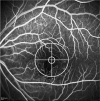Non-dipping pattern of nocturnal blood pressure as a risk factor for macular ischemia in branch retinal vein occlusion
- PMID: 34006916
- PMCID: PMC8131356
- DOI: 10.1038/s41598-021-89915-9
Non-dipping pattern of nocturnal blood pressure as a risk factor for macular ischemia in branch retinal vein occlusion
Abstract
Branch retinal vein occlusion (BRVO) is ocular vascular disease affecting approximately 14 million people worldwide, and is closely associated with high blood pressure (BP). Although macular ischemia is a critical factor in the visual prognosis of BRVO, the relationship between macular ischemia and different patterns of nocturnal BP is unknown. Here, we investigated whether a dipping pattern of nocturnal BP is associated with the development of macular ischemia in patients with BRVO. A total of 273 patients were reviewed; of these, 86 (86 eyes) patients were included. All recruited patients had a macular thickness map by optical coherence tomography and underwent 24-h ambulatory BP monitoring. According to their dipping patterns, the participants were divided into dipper and non-dipper groups. The non-dipper group had worse visual outcomes at the initial and 6-month visits (P = 0.014 and P = 0.003, respectively). Five of 32 eyes (15.6%) in the dipper group and 32 of 54 (59.3%) in the non-dipper group had macular ischemia. In a multivariate analysis, the night-to-day systolic BP ratio was associated with the degree of macular ischemia (β = - 0.313, P = 0.004). Thus, a non-dipping pattern may be a risk factor for macular ischemia in patients with BRVO.
Conflict of interest statement
The authors declare no competing interests.
Figures


Similar articles
-
Grading of macular perfusion in retinal vein occlusion using en-face swept-source optical coherence tomography angiography: a retrospective observational case series.BMC Ophthalmol. 2019 Jun 10;19(1):127. doi: 10.1186/s12886-019-1134-x. BMC Ophthalmol. 2019. PMID: 31182069 Free PMC article.
-
Association between retinal hemorrhagic pattern and macular perfusion status in eyes with acute branch retinal vein occlusion.Sci Rep. 2016 Jun 23;6:28554. doi: 10.1038/srep28554. Sci Rep. 2016. PMID: 27334338 Free PMC article.
-
Ambulatory Arterial Stiffness Index (AASI) is Unable to Estimate Arterial Stiffness of Hypertensive Subjects: Role of Nocturnal Dipping of Blood Pressure.Curr Hypertens Rev. 2017;13(2):121-131. doi: 10.2174/1573402113666170621110305. Curr Hypertens Rev. 2017. PMID: 28637401
-
Serous retinal detachment in patients with macular edema secondary to branch retinal vein occlusion.Arq Bras Oftalmol. 2016 Feb;79(1):9-11. doi: 10.5935/0004-2749.20160004. Arq Bras Oftalmol. 2016. PMID: 26840158
-
Influence of retinal ischemia on macular function after pars plana vitrectomy for macular edema with branch retinal vein occlusion.Int Ophthalmol. 2013 Dec;33(6):677-86. doi: 10.1007/s10792-013-9762-2. Epub 2013 Mar 29. Int Ophthalmol. 2013. PMID: 23539479
Cited by
-
Does Nocturnal Blood Pressure Matter in Retinal Small Vessels? A Systematic Review and Meta-Analysis of the Literature.Curr Hypertens Rep. 2025 Jan 18;27(1):9. doi: 10.1007/s11906-025-01326-7. Curr Hypertens Rep. 2025. PMID: 39826001 Free PMC article.
-
White coat hypertension in acute retinal vein occlusion.Int J Retina Vitreous. 2024 Sep 18;10(1):65. doi: 10.1186/s40942-024-00584-y. Int J Retina Vitreous. 2024. PMID: 39294758 Free PMC article.
-
Subretinal fluid in macular edema secondary to branch retinal vein occlusion.Sci Rep. 2024 Jun 13;14(1):13623. doi: 10.1038/s41598-024-64047-y. Sci Rep. 2024. PMID: 38871805 Free PMC article.
-
Relationship between platelet distribution width and non-dipping pattern in children with essential hypertension.BMC Pediatr. 2025 Jan 22;25(1):54. doi: 10.1186/s12887-025-05420-2. BMC Pediatr. 2025. PMID: 39844072 Free PMC article.
References
Publication types
MeSH terms
LinkOut - more resources
Full Text Sources
Other Literature Sources

